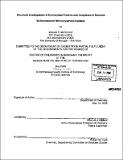Structural investigations of hydroxylase proteins and complexes in bacterial multicomponent monooxygenase systems
Author(s)
McCormick, Michael S. (Michael Scott)
DownloadFull printable version (65.85Mb)
Other Contributors
Massachusetts Institute of Technology. Dept. of Chemistry.
Advisor
Stephen J. Lippard.
Terms of use
Metadata
Show full item recordAbstract
Bacterial multicomponent monooxgenases (BMMs) such as toluene/o-xylene monooxygenase (ToMO), phenol hydroxylase (PH), and soluble methane monooxygenase (sMMO) catalyze hydrocarbon oxidation reactions at a carboxylatebridged non-heme diiron center common to many systems in biology, as discussed in the first and subsequent chapters of this document. Chapter 1 provides a summary of various relationships between structure and activity in BMMs, as they have been determined through decades of research into BMM hydrocarbon catalysis. Presented in Chapter 2 are the structures of the native (ToMOH) and manganese(ll)-reconstituted (Mn(ll)-ToMOH) ToMO hydroxylase, at 1.85 A and 2.20 A resolution, respectively. The structure of Mn(ll)-ToMOH reveals an active site coordination and geometry similar to that in diferrous and manganese(ll)-reconstituted MMOH, indicating that it represents an analog of the diferrous ToMOH structure. Through comparison of the native ToMOH and Mn(II)-ToMOH structures, a collection of metal site oxidation state dependent conformational changes in conserved residues on the surface of the hydroxylase a-suibunit are observed, suggesting a relationship between active site oxidation state and component interactions in BMMs. Through analysis of the 1.85 A ToMOH structure, a series of hydrophobic cavities through the asubunit connecting the active site to the protein surface analogous to those previously noted in MMOH were also discovered as part of this work. Chapter 3 describes three X-ray crystal structures of ToMOH T201X mutants, and four structures of ToMOH N202X mutants at resolutions ranging from 1.90 to 2.90 A. (cont.) These data reveal alterations in the ToMOH active site pocket surface topology and malformed hydrogen bonding interactions resulting from the various mutations that may respectively be responsible for substrate hydroxylation regiospecificity and proton translocation differences observed of the mutant proteins in future biochemical studies when compared to the wild-type system. Reported in Chapter 4 is a 1.95 A X-ray crystal structure of the xenon gas pressurized PH hydroxylase (Xe-PHH), along with computational analyses of the various surface-to-diiron center cavities, channels, and pores in the a-subunits of all three structurally characterized BMM hydroxylase proteins. The structure of Xe-PHH reveals extensive xenon binding in the conserved a-subunit hydrophobic cavities and suggests a role for the pathway in dioxygen transport to the active site during catalysis. Computational analyses of surface-to-diiron center cavities, channels, and pores in the BMM hydroxylase a-subunits supports findings from the Xe-PHH structure, and provides insight into how the various molecular substrate transport pathways may have been carved into the different hydroxylase proteins through evolution.
Description
Thesis (Ph. D.)--Massachusetts Institute of Technology, Dept. of Chemistry, 2008. Vita. Includes bibliographical references.
Date issued
2008Department
Massachusetts Institute of Technology. Department of ChemistryPublisher
Massachusetts Institute of Technology
Keywords
Chemistry.